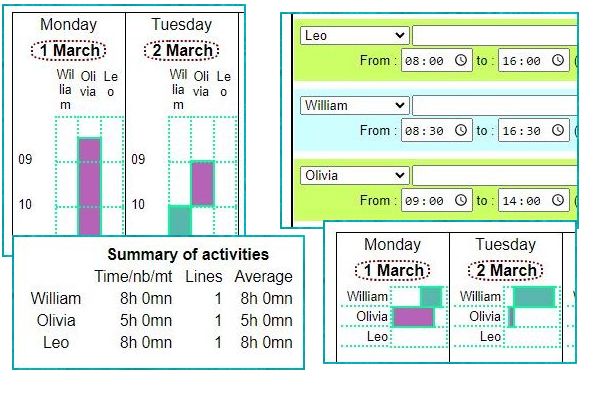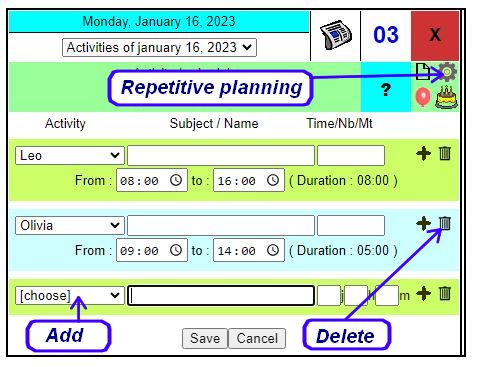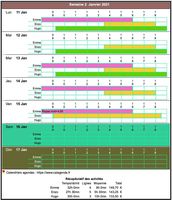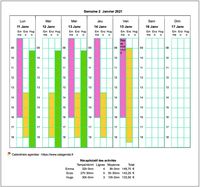This free tool will provide you with valuable help in managing your business, in particular:
- The provisional, then actual, recording of the reception of each child. This recording can be done day after day, or over a period of several days (repetitive planning).
- Display on the calendar of your choice, the schedule for each day.
- The possible preparation of pricing, taking into account the maintenance package, the meal, the hourly price and any regular or exceptional service, in order to establish a salary simulation or regularization.
- Displaying and printing summary or detailed reports, for you or the parents.

Note that all data entered is stored on your computer, tablet or smartphone, thus preserving your privacy. A backup tool will keep data secure.
Principle
- Define the general characteristics for each child (Name, hourly rate, package, etc.)
- Plan on-calls, either day by day, or with the repetitive planning tool, and define any exceptional services (more or less).
- View the schedule in detail with the weekly and monthly calendars, and in summary with the quarterly, half-yearly and annual calendars.
- Display a detailed and/or summary report for any period of one or more months, with the pricing elements of the period.
Define planning type activities
- Create an 'Activity' for each child:
In the menu at the top left, choose: Agenda > Activity Tracker > Activity List.
Complete the last line of the list, or modify an activity that already exists in the list.
Only the activity, label and type are mandatory. The other parameters can be defined later, and will be modifiable even after planning the activities.- Activity: this internal code will only be useful for recreating a line deleted by mistake. it is a code of 10 characters maximum, without accents, without spaces, and without special characters, which cannot be modified.
- Wording: name and or first name of the child: This name may be modified.
- Type: choose 'Scheduling'.
- Duration of a day: do not enter, unless you want to convert on-call hours into the number of working days, in which case, enter the duration in hours and minutes.
- Default display (excluding schedule display): allows you to define the type of display in calendars, if you choose, for this calendar, not to display the detailed schedule:
- Same as calendar (preferred option): the type of display will be defined in the 'Data' tab of the calendar.
- Box appearance: to define a box color or icon. If you choose a color, it is the color of the last shift of the day that will be displayed.
- Border: to display a simple border in the box.
- Do not display: to not display the call in the calendars (unless the display of the schedule is requested in the 'Data' tab of the calendar).
- Counting: check to include by default counting at the end of the calendar. Note that in the 'Data' tab of each calendar, you can also choose the 'With summary' or 'Without summary' options.
- Schedule: choose a schedule color. If no color is chosen, the schedule will not be displayed in the calendars for this child (useful for childcare from previous years).
- Input type: for childcare, prefer to enter a start date and an end date, otherwise, enter the default duration in minutes.
- Optionally, for possible preparation of invoicing:
- 'Day' package: enter here the amount of fixed costs (meals, maintenance, etc.) which will be counted by default each day (only once per day and per child).
- 'Intervention' package: to count, for example, travel costs. It is applied to each care when several separate cares are planned on the same day for the same child.
- Hourly cost: rate for one hour of care.
- Unit: enter € to display amounts with comma and two decimal places.
In the event of a pricing change:- The new pricing will apply to new schedules.
- The old pricing will be retained for care already planned, with the possibility of applying the new rate:
- For a given day ('Apply the new rate' option).
- For a period of several consecutive days (see below: Automatic scheduling).
- After each modification of the list of activities, click on 'Save'.
- Delete unnecessary activities for your activity , by clicking on the trash can (
 ), then click on 'Save'.
), then click on 'Save'. - Set the general options (Schedule management):
- Start time and end time of the day: any scheduling of a call outside of this time slot will be impossible, except:
- If you schedule a call without specifying a start time.
- If you schedule a call with a start time equal to the end time.
- For (exceptional) shifts registered at the end of the month.
- Conflict management: for childcare, choose 'Activity-by-activity management' to refuse the scheduling of two childcares for the same child, on the same day, during the same time slot, while accepting the care of several children at the same time time.
- For the 'Day' and 'Intervention' packages, check 'Count the package separately', if you wish to know the total of the packages at the end of the period, and adapt the wording to your case (Meals, Km, etc.).
- Check 'Account the correction separately' if you wish to know the total amounts of exceptional services applied at the time of planning.
- Click 'Save'.
- Start time and end time of the day: any scheduling of a call outside of this time slot will be impossible, except:
Plan each shift.
The recording of guards will be done either on a specific day, or over a period of several days, consecutive or not, or at the end of the month (for example to record a service outside of daylight hours).
- Display the calendar corresponding to the desired day or period.
- To record on a specific day, in the calendar (daily monitoring) , simply click on the corresponding day:
- In the dialog box that appears, choose 'Monitoring / planning of...' from the drop-down list

- To add a schedule : choose the child's name from the 'Activity' list, and enter a start time and an end time. If necessary, enter a subject and a possible pricing correction, to invoice an amount different from that defined by default in the list of activities. This amount must then be preceded by one of the signs '+', '-' or '='.
- A '+' will indicate that the following amount will be added to the default calculation, for example to bill an additional service.
- A '-' will indicate that the following amount will be deducted from the default calculation, for example to apply a discount.
- The '=' sign will indicate that the amount entered will be replaced by the default calculation. (for example, entering '=0' will indicate that the service will not be invoiced).
Validate with the Save button . Several input checks will be carried out:- The activity start time cannot be lower than the start time of the day.
- The end time of activity cannot be less than the end of day time.
- It will be impossible to schedule two childcare arrangements for the same child at the same time.
- Tip : To force recording, either outside of daylight hours or in conflict with another activity, set the start and end times the same, or do not enter a start time.
- To delete a schedule , click on the trash can (
 ) at the end of the line of the activity to delete, then validate with the Save button .
) at the end of the line of the activity to delete, then validate with the Save button . - To modify one or more schedules , optionally modify the start time, end time, billing, subject or name. Validate your changes by clicking Save.
- If you want to make several modifications in the same month, for several dates, move the dialog box with the mouse by clicking on its title. The box will then be docked. To make the box floating again, click on the red cross.
- You can move calendars by clicking on the hand (
 ), for easier entry.
), for easier entry.
- In the dialog box that appears, choose 'Monitoring / planning of...' from the drop-down list
- Automatic scheduling , daily, weekly, bi-weekly, monthly, new rates, scheduling conflicts...
- In the menu at the top left, choose: Calendar > Activity Tracking > Automatic Scheduling.
- Choose a start date and an end date.
- Choose the type of planning to do: every day or a specific day of the week.
- In 'Activity', select the child's name.
- Select the update type.
- 'Replace': to replace any childcare planned for this day, for this child, with another childcare.
- 'Add unless there is a scheduling conflict': to add only if another shift in the same time slot is not already scheduled.
- 'Add even if an activity already exists': This option is not recommended, as it will add the activity even if there is a scheduling conflict.
- 'Find scheduling conflicts': to obtain the list of conflicts, and correct them from this list.
- 'Apply new rate': this option is useful for applying a new rate to activities planned with the old rate.
- 'Delete activities of this type': to delete childcare planned for this child, in this period.
- Optionally enter a subject, a start time, an end time, and a price correction (see above).
- Click 'Update', or in the case of conflict searches, 'Search'.
- If scheduling conflicts have been detected, correction of these conflicts will be possible directly from the list (click on each day...)
- For a global recording at the end of the month (a priori exceptional), click at the bottom of the calendar, on the logo
 or on the text " Calendars: /calendriers.htm". :
or on the text " Calendars: /calendriers.htm". :- In the dialog box that appears, choose 'Monitoring / planning' from the drop-down list.
- The procedure is then identical to entering for a specific day.
- In the event of a rate change, to apply a new rate to an old recording, display the dialog box and click on 'Apply new rate'.
Display the details and total of shifts carried out in the calendar of your choice:
The customizable calendars below are intended for the childminder activity.
- Display of the detailed schedule in a vertical format weekly calendar.In this calendar, times are displayed horizontally. Use the different tabs located above the calendar (Calendar, Month, Boxes, Info, etc.) to personalize it.
- Display of the detailed schedule in a horizontal format weekly calendar.In this calendar, times are displayed vertically.
- Detailed monthly calendar.This calendar displays all schedules in text form, with any pricing information, as well as a summary table.
To display only the data of a child or family, in the 'Data' tab, select 'Tracking only' in 'Calendar', and select one or more children in 'Activity tracking'. - The calendars above are given as examples, but all models on the site are compatible with activity tracking.
- Calendars are customizable using the different tabs above each calendar, for example:
- Customize the design with the 'Calendar', 'Month' and 'Boxes' tabs: dimensions, margins, borders, etc.
- Decide what information to display with the 'Data' tab: names of saints, school holidays, calendar data, birthdays, and of course, data corresponding to guards, with or without the summary at the end of the period. For example, you can display all childcare, or only display childcare for one child, or for several children in the same family.
- Save your customization with the floppy disk (
 ), in order to find your favorite calendar by default each time you open the browser.
), in order to find your favorite calendar by default each time you open the browser.
Obtain a summary (child by child) or detailed (list) report, or do a search.
- From the menu at the top left, choose 'Direct Access', 'Calendar', 'Search' .
- Next to 'Period', choose 'Select', and choose a month, year and duration.
- Next to 'Data, choose 'Select', and uncheck 'Agenda' and 'Periodic Reports'. Next to 'Activity Tracking', choose 'Select'.
- From the list of activities, choose the one(s) that concern you. For example, you can choose only the child(ren) of a family, to obtain a report for the parents.
- If you do not specify a filter, all selected activities corresponding to the period will be displayed, as well as the corresponding summary report. The ''Count'' and ''Show'' boxes allow you to restore either the detailed list, the summary report, or both. The filter allows you to carry out a specific search, for example on an exceptional service entered during planning (diapers, meals, etc.).
- Click Search to get the answers to your query.
- The detailed report will display for each day, all the shifts concerned, with the start date, the end date, any observations and pricing information.
- The summary report will give, for each child, the number of hours of care for the period, the average time of care and the total pricing corresponding to the period.
To display the names in alphabetical order, sort the activities by label . - Customizing the layout (specific title, page width and border, font and character size, day and month format, etc.) allows you to obtain a personalized report, for example for printing or creating a PDF file for parents.
- The 'Save my preferences' button saves time next time...
Back up your data.
- All your personal data is stored in real time on your computer, tablet or smartphone. This method preserves your privacy.
- In return, you must perform a security backup periodically, for example every month. The procedure is very simple: choose 'Direct access', 'Calendar', 'Export'... Save the file on your hard drive, a USB key or in the cloud.
Documentation on backup / export is available with the menu at the top left: 'Diary', 'Export / Backup'. - Exporting will also be useful for viewing your calendar on several computers, your tablet or your smartphone. The export form allows for example a partial export, over a given period, or even the export of a single activity, for a possible exchange with parents.
 You have an export function in csv format , for import into a spreadsheet (Excel, OpenOffice, LibreOffice, etc.) for example to archive the past year.
You have an export function in csv format , for import into a spreadsheet (Excel, OpenOffice, LibreOffice, etc.) for example to archive the past year.





 Voir cette page sur le site français
Voir cette page sur le site français